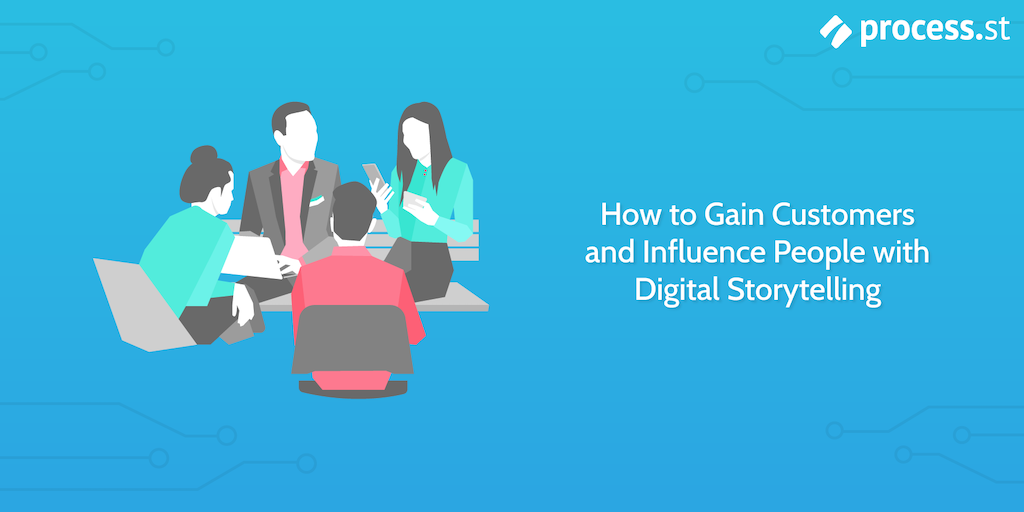
“Once upon a time…
A fledgling young business set upon a quest…
To incorporate digital storytelling…
After hearing of its success.They scoured the web…
During all hours of night and day…
For digital storytelling techniques…
So their customers would stay.But they couldn’t quite find…
The resources they sought to seek…
Until, that is, they found this blog post…
Written by the team at Process Street.”
– Anon
Storytelling.
It’s a medium nearly as old as time itself.
From the visual scribblings made over 30,000 years ago by our cavemen cousins to the 18th-century fairy tales about dwarves, goblins, ghouls and demons made popular by the Brothers Grimm, the human need for stories runs deep.
Luckily for us living in the 21st century, we have the digital and technological means to bolster the stories we tell in unprecedented ways.
And from a marketing standpoint, digital storytelling is something of a holy grail; with it, businesses can gain, engage, connect, influence, and retain customers.
So, if you’re on a quest to learn about digital storytelling and how to incorporate it into your marketing plans, you’ve come to the right place, adventurer. Read through the sections below:
- Chapter 1: What is digital storytelling?
- Chapter 2: The benefits of digital storytelling
- Chapter 3: Brands effectively utilizing digital storytelling
- Chapter 4: The digital storytelling tools of the trade
- Chapter 5: How Process Street can aid digital storytellers
Let’s begin.
Chapter 1: What is digital storytelling?
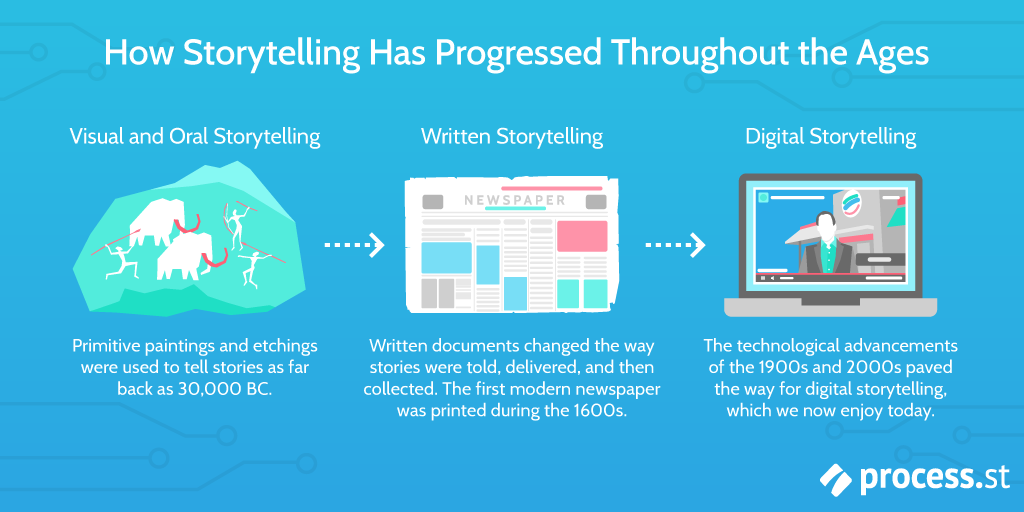
Before we delve deeper, we must first appreciate the art of storytelling itself. After all, the development of storytelling has ultimately led us to its most contemporary form; digital storytelling.
So join us around the campfire. It’s time for an epic tale.
The history of storytelling: cave paintings
Thousands of years ago – over 30,000, in fact – brave hunters and ordinary folk alike wanted to tell their tales. But without a fully-developed language, they resorted to other means, such as cave painting.
The paint was made from charcoal and dirt, mixed-in with human spit or animal fat. To make the different colors, materials from the immediate locality were used; pigments from minerals, calcite, and even burned bones. Then, they’d apply the paint to the naturally porous cave walls.
Archaeologists and historians believe that the cave paintings on the Indonesian island of Sulawesi are some of the oldest on Earth, if not the oldest.
On the cave walls of Sulawesi, it’s possible to see depictions of humans hunting or, as was sometimes the case, being hunted.
These primitive illustrations tell the stories of struggles and success, trials and tribulations, just as modern books do.
Which brings us onto the next point…
The history of storytelling: printing
After centuries of stories being told through gestures, paintings, oral methods, and music, storytelling was completely revolutionized by printing.
Although printing can be dated as far back as 220 A.D. with woodblock printing, it wasn’t until printing houses were established that physical, readable material became more commonly produced.
Think about it for a second.
Instead of having to hear or see a story first-hand, you could own a story in physical form and keep it in your home and be able to read it time and time again, at your own leisure.
It was groundbreaking.
Then, in the 17th and 18th centuries, newspapers were made, circulated, and read, helping to push the forms of storytelling even further. The first “proper” newspaper in America (read: the paper that was closest to our 21st-century newspapers) was published in 1690 and called Publick Occurrences Both Forreign and Domestick.
By the early 19th century, newspapers were printed quickly, bought swiftly, and sold cheaply. Local and global stories were told to eager readers. Every. Single. Day.
The history of storytelling: digital storytelling
Printing revolutionized storytelling, yes, but progress didn’t end there. Further technological advancements pushed storytelling into previously unthinkable realms. Introducing electronic storytelling.
With the radio (the first news broadcast was in 1920), curious listeners could hear worldly goings-on from the comfort of their own homes.
The television (the world’s first television network was W2XB, broadcast from New York in 1928) also bumped up digital storytelling a notch or two.
TV combined the age-old forms of oral, visual, and aural storytelling with modern technology. Whether told via news reports or fictionalized dramas, stories lit up the living rooms of countless households. They informed, entertained, and engaged people who, just as their caveman cousins were, were hungry for stories.
Then came video games (1958).
Then music videos (1981).
The internet (1991), which promoted electronic storytelling to digital storytelling.
Blogs (1994).
Social media (1997).
Web 2.0 (2004).
Virtual reality (2010).
Digital storytelling, then, is the melding of ancient storytelling techniques with contemporary, digital forms.
As social and cultural historian Sara S. Goek further explains:
“Digital storytelling is the latest iteration of a narrative tradition. It involves creating and sharing stories using digital tools, incorporating multimedia elements such as image, sound, and words in a narrative that is then disseminated via a web platform.” – Sara S. Goek, Keeping Up With… Digital Storytelling
And for storytellers, there’s no better age to tell stories in than this one.
Chapter 2: The benefits of digital storytelling
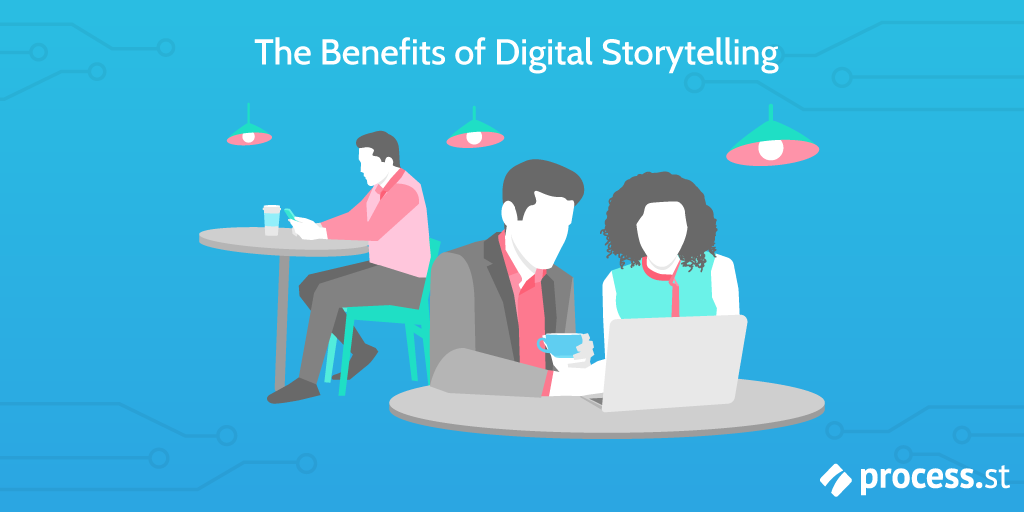
Stay around the campfire a little longer, adventurer. The night is dark and full of tellers. Before you venture out to usurp the others and become the best storyteller in the land, you must grasp the benefits of digital storytelling.
Here’s what digital storytelling can do for you and your business.
Digital storytelling engages audiences, quickly
As modern-day humans, we scroll through news, blog, and social media feeds as quickly as our thumbs can take us. Online content, therefore, needs to capture attention. And fast.
With interesting visuals, well-written text, and even the use of sound, digital storytelling can awaken an audience’s senses and engage them in record time.
Digital storytelling changes perceptions
Let’s be honest: Not everybody’s interested in hearing about a new brand, campaign, project, initiative, product, service, or tool, and why they absolutely need to get involved. Not only has ad saturation caused people to disregard ads, but it’s also led to higher levels of distrust.
However, digital storytelling can help reverse these issues. It can promote your business differently to the rest; you have a worthy cause, a commendable mission, a real purpose.
Digital storytelling shows that you’re not like other businesses; you’re better.
Digital storytelling establishes an emotional connection
When it comes down to evaluating a brand, product, or service, consumers are initially led by their emotions. So by bringing certain emotions to the fore – whether it’s admiration, amusement, excitement, nostalgia, sympathy, sadness or intrigue – you’re creating and strengthening the viewer’s emotional connection with your brand.
After I saw Apple’s ad on how their products are being used to improve the lives of those with extra accessibility needs, I’m not ashamed to say a few emotions were brought to the fore.
Digital storytelling can have relatable elements
According to Nielsen‘s Global Trust in Advertising Survey, 44% of global respondents said ads which depicted real-life scenarios stayed with them the most.
No matter whether it’s a character whose morning routine consists of sleeping through their alarms despite them needing to wake up earlier, or a person with accessibility needs like in the above Apple ad – relatability resonates. And it’s relatability which makes brands all the more memorable for consumers.
Digital storytelling is the perfect vehicle for telling stories and incorporating relatable elements in it.
Digital storytelling educates and informs
Eye-catching visuals… check. ✅
Captivating use of sound… check. ✅
Story…? ❌
Without a story being told, you’re not informing viewers of anything. You’re, instead, subjecting them to a random assortment of audio-visual material.
But by telling a story, you’re passing knowledge onto others about a brand, project, initiative, product, service, or tool. With digital storytelling, all you have to do is decide what it is you want viewers to learn, and the ways you’re going to tell that story!
Digital storytelling is certainly Herculean in its power. But it’s important to remember that digital storytelling doesn’t intently focus on one single metric or KPI, but instead, a number of them in broader detail.
So, if you’re looking to generally improve engagement, connection, and loyalty across the board, digital storytelling is the strength that you seek.
Chapter 3: Brands effectively utilizing digital storytelling
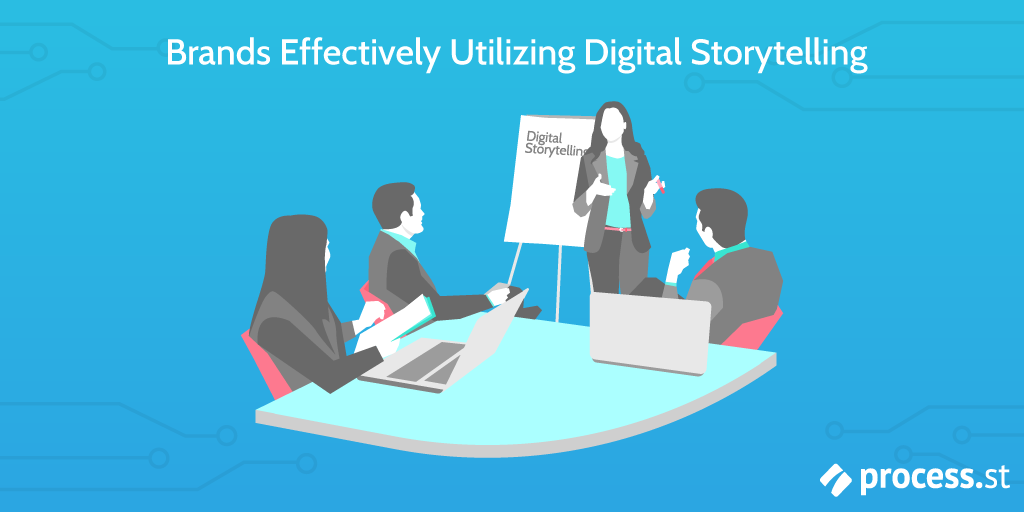
The three companies in this section – Apple, Patagonia, and Monotype – are all modern-day maestros of digital storytelling. In fact, they all place a tremendous emphasis on digital storytelling as a premium marketing strategy. And it works.
As the late, great Steve Jobs once said regarding storytelling’s usefulness in business:
“The most powerful person in the world is the storyteller. The storyteller sets the vision, values and agenda of an entire generation that is to come.” – Steve Jobs
Let’s take a look at how these three leading companies do it.
Apple: Cinematic storytelling
Apple has been mentioned a few times now, and that’s for good reason.
With a net worth of $1 trillion, Apple isn’t only a trailblazer when it comes to well-designed, forward-thinking tech, but it’s also at the helm of stellar digital storytelling.
There have been countless ways Apple has used digital storytelling to create amazing content, but the first time the world really took notice was when their advertisement for the 1984 Apple Macintosh was released.
The beginning of the ad shows the inside of a grey, monochrome building, which has wan and sickly-looking humans slowly marching inside. An overpowering voice blasts out from the telescreens, saying that the “Unification of Thoughts” is a powerful tool and that pure ideology will prevail. Ultimately, there’s to be no original thought or creativity in this dystopian hellscape.
That is, until, our heroine appears. With an illustration of the Apple Mac on her tank top and a hammer in her hand, the athlete runs faster than the thought police, and makes her way to the master screen where the evil mastermind is spewing his Big Brother-esque vitriol.
When close enough, the heroine throws her hammer at the screen, causing it to explode, leaving all the wan, sickly-looking people shocked as they’re set free from their shackles.
Then, the words “On January 24th, Apple Computer will introduce Macintosh. And you’ll see why 1984 won’t be like 1984.” are seen and heard by the viewer.
Our hero, Apple, brings color and creativity to the world.
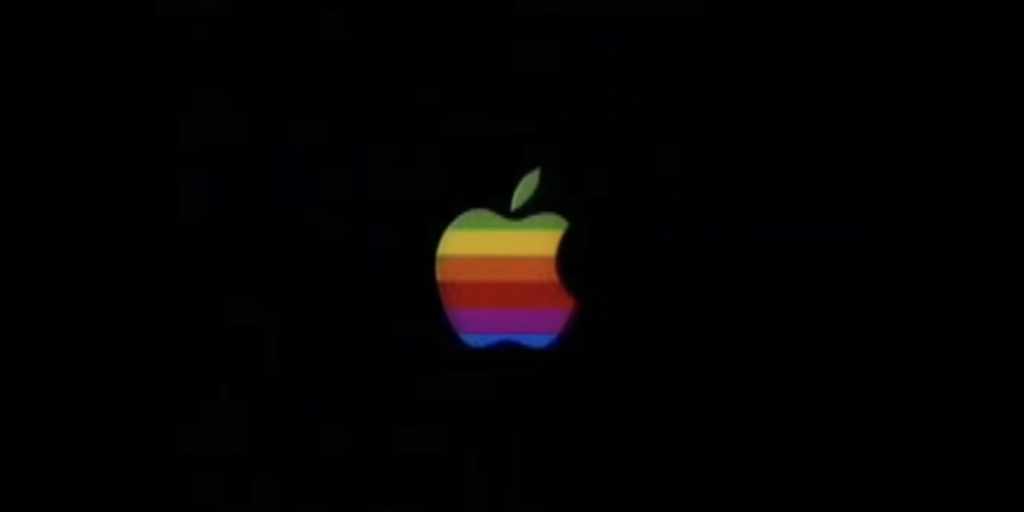
Now, depending on your personal opinion of Apple, you may love or loathe this ad in which they place themselves as the champion of, well, existence itself. (Especially considering that the evil mastermind in the ad was supposed to represent IBM and their domination of the technology market.)
But you can’t deny the fact there’s an engaging story being told.
Apple used all the tools they had access to in 1984 – a clear narrative which refers to George Orwell’s novel 1984, motion video (the ad was directed by Ridley Scott!), effective use of sound (as well as the omnipotent voice, there are oppressive, machine-like sound effects), and well-written copy.
The end result is thought-provoking content which certainly makes the viewer feel emotions and thus engaged in some degree.
Now, let’s look at how Apple has carried on using digital storytelling to engage us, change our perceptions, and establish an emotional connection with their brand and products.
Earlier I mentioned Apple’s 2016 accessibility ad. You can watch it again here.
(I won’t however, as my emotional reaction will surely put out the campfire we’re all huddled around.)
But the undeniable strength of this advertisement is how it makes us feel.
Emotive, atmospheric music is played as we’re introduced to the first person in the ad, Sady Paulson. You can then hear her voice, which is played through a speech generation device, as she has Cerebral Palsy.
She informs the reader that:
“People think that having a disability is a barrier. But that’s not the way I see it.” – Sady Paulson, Apple – Accessibility
Then, the video takes us through how Apple products are being used to make life that little bit easier for people with accessibility needs. Whether that’s those who are hard of hearing using FaceTime to communicate quickly, or those who are hard of sight using the voice assistant to help them take a photo, there are additional features in Apple products to simplify life.
Then, there’s a twist at the end. The camera pans round to show Sady Paulson, whose voice we heard throughout the video, at her desk and editing the video we’ve been watching.
That’s right. Paulson edited the entire video via Apple’s Switch Controls.
Although the video shots, emotive music, and voiceover all pulled the viewer in, it was the little narrative twist at the end that completed the story in an unexpected, uplifting way. It was the digital storytelling equivalent of wrapping a present with a bow.
Additionally, by visually showing people with additional accessibility needs, those who are watching the ad who have similar needs themselves can think “Hey, that person’s like me!” thus instilling relatability and strengthening that emotional connection to the brand even further.
Suffice to say, Apple is one of the most adept digital storytellers in the game.
Patagonia: Cinematic digital storytelling and customer-led storytelling
While we’ve already used Patagonia as an example of how to be a sustainable business, Patagonia is also a shining example of how to do great digital storytelling.
Although there’s a wide range of exemplary content from Patagonia, I want to focus on the video below.
This piece of content doesn’t use gimmicks to grab our attention. Instead, we hear the plucking of a guitar and we see a few sentences in unpretentious type on the screen, which introduces the story’s narrative to us.
It’s humble, simple, and it entirely coincides with Patagonia’s down-to-earth brand.
We’re then taken on a journey alongside Patagonia’s clothes repairers (Patagonia employ 45 full-time “repair technicians” at their repair facility in Reno, Nevada) as they venture out into the rough and rugged Nevada landscape, helping stitch back together Patagonia garments which are frayed, cut, or have simply disintegrated.
When the video doesn’t focus on the repairers themselves, it shows the people whose clothes have been damaged. They tell their personal stories regarding their clothes and what the garments mean to them.
One man explains:
“These were my only board short for six or seven years. My brother got them for me as a gift from Goodwill in Nantucket back on the East Coast. I mean, they were my go-to for everything. Surfing, just going to the beach, kayaking; [there are] a lot of memories associated with them and I hold onto them.” – A customer’s personal anecdote, Better Than New – Patagonia’s Worn Wear® Repair Truck & Facility
The video, which was originally published in 2015, then ends with a CTA asking viewers to join the repairers on their Worn Wear tour, meaning Patagonia customers could’ve had their garments repaired rather than them having to buy entirely new products.
Now, although there’s an unpretentiousness to this particular piece of content, that doesn’t mean Patagonia isn’t incorporating many digital storytelling techniques.
In fact, they’re using a whole bunch of ’em.
Take the crux of the video: The customers with repaired garments. They’re all visibly pleased with their repairs, and they tell us how much their pieces of clothing mean to them and how happy they are to have them be wearable again.
This is customer-led storytelling. Patagonia is letting ordinary folk – rather literally – do the talking for them. And considering that 92% of people trust peers over what they perceive as traditional advertising methods, this is bringing in and engaging viewers hook, line, and sinker.
Patagonia’s utilization of digital storytelling techniques doesn’t end there, either.
Like Apple, this piece of content features a combination of text, video, music, and relatable, human elements within the narrative. And they’re using all these techniques to get the message across that Patagonia is an environmentally-conscious, responsible brand which has a worthwhile mission.
Positioning themselves like this goes in their favor, of course. 81% of people say they’d put their money where their mouths are and make personal sacrifices to address social and environmental issues. Thus, they’d buy from ethical brands like Patagonia as opposed to brands that don’t have their sights on being ethically and morally conscious.
That’s a financial win for Patagonia, and facilitated via digital storytelling!
Monotype: Interactive digital storytelling
To say that Helvetica has had an interesting history is an understatement.
It’s one of the most-loved fonts of both the 20th and 21st century, it’s used for the iconic New York City transit system, and it’s even had its own documentary.
So when digital typesetting and typeface company Monotype chose to release Helvetica Now – a variation of Helvetica that was purpose-built for digital mediums – Monotype knew they had to show the font off in an innovative way.
And they did, via digital storytelling.
As soon as the viewer visits the Helvetica Now webpage, which can be found here, the viewer is presented with a minimalist-yet-visually-captivating GIF.

As the words move and jump in an aesthetically pleasing way, the viewer is informed what the typeface is about, what it can do, and why it’s lightyears ahead of its previous iterations.
Moving down the page, the viewer is met with copy which tells the reader more about Helvetica Now.
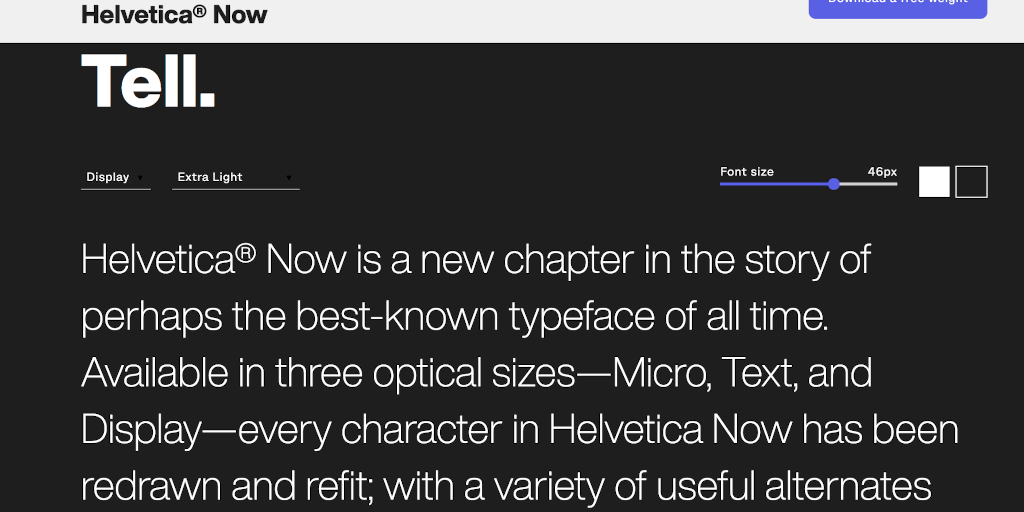
On closer inspection, it becomes noticeable that the text in the widget can be deleted, edited, or added to. To boot, it’s also possible to change between font size, weight, and even the color of the text and background.
Essentially, this block is an interactive playground where users can give Helvetica Now a test run themselves.
…And I couldn’t help but give it a try.
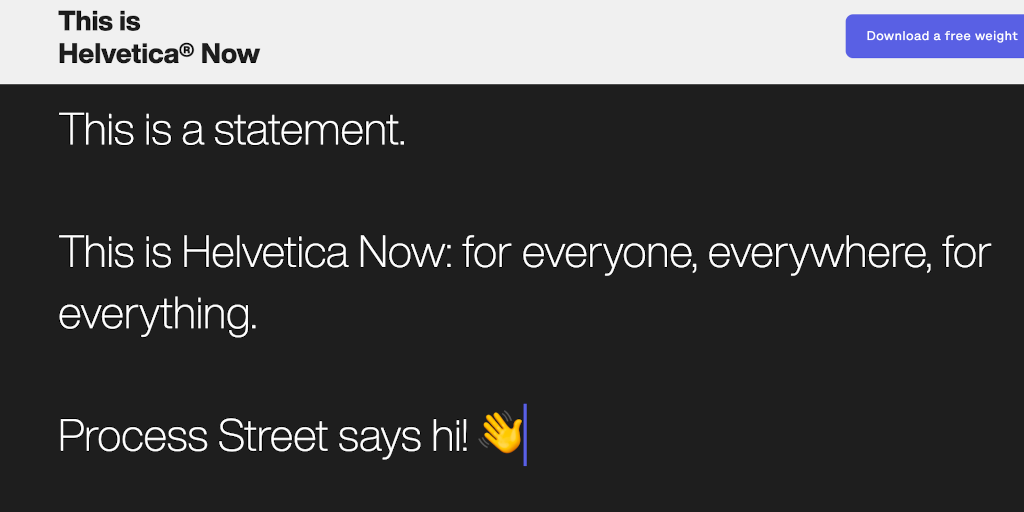
After that block, there’s another block where every single Helvetica Now font size can be tested, a block where visitors can explore all the glyphs, and even a promotional video that’s embedded in the webpage that visitors can check out.
With the above additions, the interactive playground is upgraded to an interactive and utterly engaging theme park.
Then comes the final feature – the “Designers” section.
As well as the “Designers” section being masterfully laid out, there’s a short paragraph of copy which discusses the history of the project, and next to it, the names of the designers involved alongside their portraits.
Now, Monotype isn’t simply giving themselves a pat on the back by adding their names and photos here – they’re making the project that bit more relatable and human.
The page, thus far, has lacked a human quality. (We have been looking at typefaces, after all.) But by putting human faces and names to the project, it has helped to humanize the typeface, the work that’s gone into it, and make visitors think “I can connect with this project so much more now that I’ve seen the people behind it.”
It’s a simple touch. Yet astonishingly effective.

Suffice to say, Monotype has utilized innovative web design, visual stimuli, and elements that can be interacted with first-hand to really tell the story of Helvetica Now – and sell it.
Monotype’s digital storytelling prowess gained them notoriety when launching Helvetica Now, with prominent publications like The Verge, Wired, and Fast Company giving the product and Monotype invaluable exposure.
If it hasn’t yet been realized, the reason why I chose Monotype as an example is simple: Digital storytelling doesn’t have to only come in the form of a cinematic advertisement. It can be content on a blog, an engaging GIF, an interactive element on a webpage.
Ultimately, there are so many ways in which digital storytelling manifests itself, and Monotype’s promotion of Helvetica Now shows just that.
Chapter 4: The digital storytelling tools of the trade
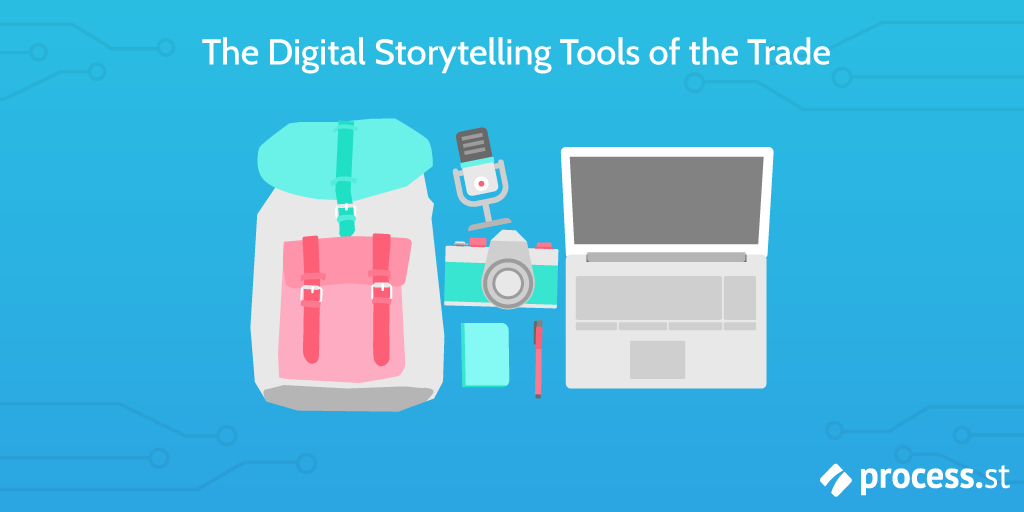
In the above section you learned that there are multiple ways to go about digital storytelling.
But this epic tale is about to take an unexpected turn.
Did you know that only 10% of content marketers are actively making use of digital storytelling?
I can only put it down to a lack of knowledge concerning what the tools are to make digital storytelling possible.
To help you take full advantage of digital storytelling, I’m going to clearly lay out the tools of the trade every seasoned digital storyteller must use!
- Blog posts.
The written word has always been a powerful tool for telling stories, but it was with Web 2.0 that the written word became extremely powerful. Nowadays, digital storytellers are not only penning amazing pieces that can be read by the world instantaneously, but they’re also heightening their blog posts with GIFs, videos, sound, and interactive web design. As a matter of fact, 55% of marketers say that blogging is one of their most important inbound marketing processes as it engages visitors, drives traffic, and then converts traffic into leads.
- Social media.
Like. Follow. Retweet. Share. Around 2.89 billion people are using social media, so that’s a lot of liking, following, retweeting and sharing that’s happening. And through digital storytelling on social media and video platforms, your business can gain some of that internet-based digital engagement for itself. Whether it’s via a sharp, snappy 30-second visual ad or a 30-character tweet that captures readers’ attention à la Denny’s Twitter feed, social media is one of the best tools around for digital storytelling, providing you with an engaged social media following.
- Video.
Humans process visual material 60,000 times faster than text. That’s why video as a tool for telling stories digitally is, hands down, one of the best. The aforementioned Apple and Patagonia videos were so effective not only because they told stories well, but they also told them quickly. So for grabbing attention stat, tell stories via video.
- Web design.
Web design is a valid form of digital storytelling. If you’re telling a story via web design, then yes, other elements like text and videos might be included, but the primary vehicle is the design of the webpage or site. Two quintessential examples of web design being used as a tool for digital storytelling can be seen via experimental-folk musician Bon Iver’s website, and Microsoft’s Building with AI webpage.
- Podcasts.
Podcasts are extremely popular. In fact, there have been over 50 billion podcasts downloaded since Apple Podcasts launched back in 2005. Podcasts are a fantastic method for telling stories digitally: They’re easy to make (you can even automate podcast production!) and can be listened to while on the daily work commute, at the gym, or in the comfort of one’s own home. Ergo: Podcasts are versatile, effective, and cost-effective, at that.
This isn’t a comprehensive list, of course; as times change and technology develops, the tools and mediums for digital storytelling will differ.
However, the 5 tools listed above – blog posts, social media, videos, web design, and podcasts – are the core tools you need to have under your belt. (Or your content marketer’s toolbox, backpack, or laptop – wherever you keep the tools you need to use daily!)
Chapter 5: How Process Street can aid digital storytellers
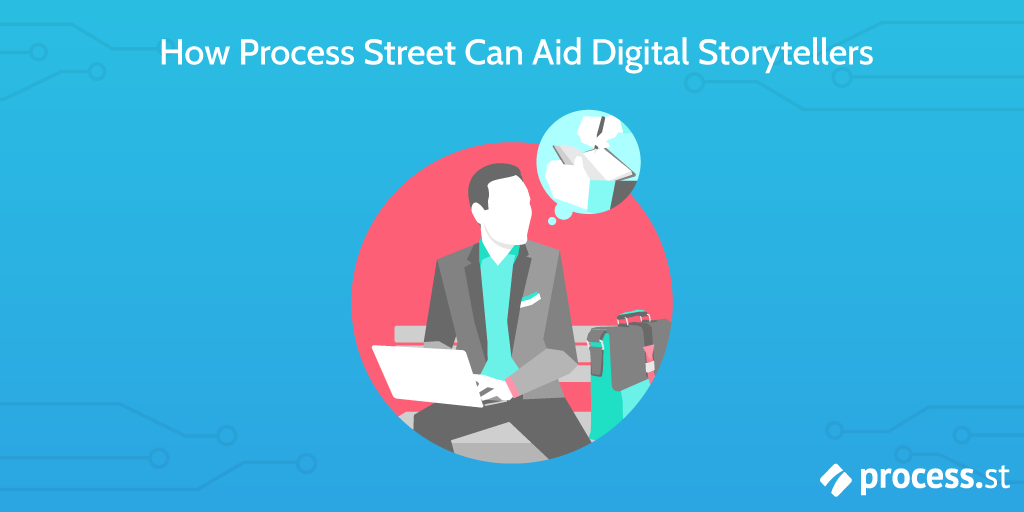
There you have it.
You now know what digital storytelling is, why it’s beneficial, who’s making the most of digital storytelling, and even the tools you need to become the George R. R. Martin of marketing.
But before you start on your journey, there’s another tool you must have as a part of your arsenal – Process Street.
Process Street is supercharged checklists.
By following checklists, you and your team can guarantee every step of a crucial, recurring process is followed. So, no matter if you’re launching an interactive website or creating an engaging, well-written blog post, the tasks will be completed to a high standard.
And what makes our checklists supercharged is the additional built-in features.
For example, stop tasks ensure critical steps aren’t skipped, conditional logic means checklists adapt to your needs, and with task permissions, you can hide steps from certain users, which is great for collaborating with guests!
Get a free account to our BPM software and start making amazing checklists today. Don’t worry, making checklists can be quick and easy, and certainly won’t take you 7 years.
Additional Process Street resources for digital storytellers
If you don’t want to jump into making your own processes just yet, there’s a few ready-made templates you can jump into and use straight away.
- Blog Idea Processing Checklist
- The Ultimate Blog Post Editing Checklist
- Blog Pre-Publish Checklist
- Creating a Newsletter
- How to Market on Instagram – The Ultimate Guide
- Podcast Publishing Checklist
- Visual Content Publishing Checklist
- Website Launch Checklist
- Brand Identity Design
- Web Design Process
Here’s to becoming a great digital storyteller!
Have you used digital storytelling as a part of your marketing campaigns? Are there any tips or tricks you’d like to share with the Process Street community? If so, write them down in the comment section below!







 Workflows
Workflows Forms
Forms Data Sets
Data Sets Pages
Pages Process AI
Process AI Automations
Automations Analytics
Analytics Apps
Apps Integrations
Integrations
 Property management
Property management
 Human resources
Human resources
 Customer management
Customer management
 Information technology
Information technology



Thom James Carter
Thom is one of Process Street’s content writers. He’s also contributed tech-related writing to The New Statesman, Insider, Atlassian, G2, The Content Marketing Institute, and more. Follow him on Twitter @thomjamescarter.